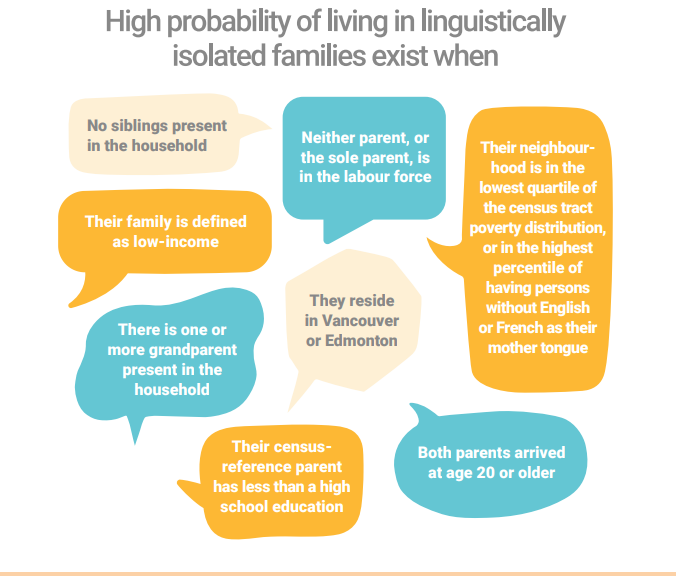Family Contexts of Migrant Children: Language and Other
Socioeconomic Inequalities
Research Team: Monica Boyd1 and Soli Dubash1
Affiliation: University of Toronto1
Keywords: immigrant children, immigrant families, language development, language use, socioeconomic inequalities, poverty, linguistic isolation, second-language acquisition, quantitative methods
Jump to: Full Infographic, Methodology, Findings
Summary
Overview: Using 2016 census data, this research explored the prevalence and probability of linguistic isolation among newcomer children aged 0-12 residing in Canadian census metropolitan areas. Linguistic isolation occurs when none of the family members aged 14 and older regularly use English and/or French at home.
Objective: To understand how prevalent it is for newcomer children to live in linguistically isolated families; the individual-, meso-, and macro-level factors influencing linguistic isolation; and the affects of linguistic isolation on children’s use of French and/or English in the home.
Research Justification: Research shows that language use in the home affects early childhood development. This study takes an innovative approach by considering the broader family context on children’s language use through the creation of family files from census data.
Infographic Excerpt

Methodology
This study used the 2016 Canadian census to construct family files as the focus of analysis. The sample included families where the census-reference person is an immigrant (permanent resident) who arrived at age 20 or older and is currently 25 or older with at least one child aged 0-12. The analysis included families residing in census metropolitan areas (CMAs), defined as cities of 100,000 people or more, and excludes families where one or both parents are Canadian-born, same-sex cohabiting or married families, and persons in aboriginal families or living in band housing.
Multivariate analysis was used to determine the individual-, meso-, and macro-level factors that affected the probability of children living in linguistically isolated families; how immigration related characteristics of the census reference parent (the parent who filled out the census) affected the levels of linguistic isolation for children; and whether living in a linguistically isolated family was associated with reduced use of English and/or French by school-aged children (5-12 years old).
Findings
- One in five newcomer children under the age of 13 live in linguistically isolated families.
- The highest probability of living in linguistic isolated families exists for newcomer children aged 0-12 when:
- There are no siblings present in the household
- Their family is defined as low-income
- There is one or more grandparent present in the household
- Their census-reference parent has less than a high school education
- Both parents arrived at age 20 or older
- A sole parent (or neither parent) is in the labour force
- They reside in Vancouver or Edmonton
- Their neighbourhood is in the lowest quartile of the census tract poverty distribution or in the highest percentile of having persons without English or French as their mother tongue.
- The probability of children living in linguistic isolation is lower when the census reference parent:
- was born in a country where the language of use included English or French
- has been living in Canada since the 1980’s compared with more recent arrivals.
- Visible minority status, area of birth, and visa admission categories also affected the likelihood of children’s linguistic isolation:
- 12-16% of children whose census reference parent identified as Black or Arab are likely to live in linguistically isolated families, compared to 27-33% of children whose census reference parent identified as South Asian, Chinese, Southeast Asian or Japanese.
- The probability of children living in linguistically isolated families is 34% for those whose census reference parent entered as a government sponsored refugee, 29% for those whose parent entered in the privately sponsored class, and 28% for those who entered in the family class. For those whose census reference parent entered in the skilled worker or live-in-care visa categories, the predicted probability of children living in linguistically isolated families is 17%.
Explore more projects


